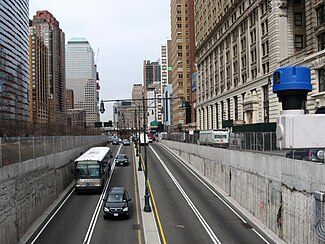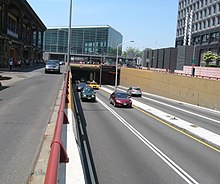 Western portal at
West Street | |
| Overview | |
|---|---|
| Location | Battery Park, Manhattan, New York City |
| Coordinates | 40°42′09″N 74°00′58″W / 40.70250°N 74.01611°W |
| Route | |
| Start | |
| End | |
| Operation | |
| Constructed | 1949–1951 |
| Opened | April 10, 1951 [1] |
| Closed | October 29, 2012 [2] |
| Reopened | November 13, 2012 [3] |
| Traffic | Automotive |
| Character | Limited access |
| Technical | |
| No. of lanes | 4 |
| Operating speed | 30–40 miles per hour (48–64 km/h) |
| Tunnel clearance | 12 feet 7 inches (3.84 m) |
The Battery Park Underpass is a vehicular tunnel at the southernmost tip of Manhattan, New York City, near the neighborhoods of South Ferry and Battery Park City. The tunnel connects FDR Drive, which runs along the east side of Manhattan Island, with the West Side Highway ( New York State Route 9A, or NY 9A), which runs along the island's west side. Opened in 1951, it was the second section of the FDR Drive to be completed. The underpass crosses beneath the Battery (formerly Battery Park) and the approach to the Brooklyn–Battery Tunnel.
History

The underpass started construction in 1949 [4] and opened to the public on April 10, 1951. [1] The underpass runs underneath the Battery, connecting the West Side Highway to the South Street Viaduct with two lanes of traffic in each direction. [1] The project was completed shortly after the opening of the Brooklyn-Battery Tunnel in 1950, and provides direct access between the West Side Highway and FDR Drive. [5]
In 2005, during the reconstruction of NY 9A, the western end of the Battery Park Underpass was extended to the north by about 25 feet (7.6 m) to provide a U-turn lane and amenities for pedestrians and bicyclists. [6]
During Hurricane Sandy, the tunnel was filled with seawater and required major repairs. [7]
Plans for extension
There have been three proposals to extend the tunnel north on the FDR Drive side.
- In 1971, it was suggested that the South Street Viaduct be turned into a tunnel, essentially extending the underpass north to the Brooklyn Bridge
- In 2002, the Downtown Alliance, the local business improvement district, called for a 350-foot (105 m) extension to the underpass to create a plaza in front of the Battery Maritime Building. The estimated cost was $70 million. [8]
- In 2005, Mayor Michael Bloomberg also called for an extension of the underpass near the Battery Maritime Building as part of a plan to rehabilitate the South Street Viaduct. [9]
References
- ^ a b c "City Opens Underpass at Battery, $10,000,000 Link in Express Route". The New York Times. April 11, 1951. p. 31. Retrieved April 12, 2010.
- ^ Newman, Andy (November 13, 2012). "Battery Tunnel Partly Reopens to Motorists". The New York Times.
- ^ "Reopening of the Battery Park Underpass to Westbound Buses for Afternoon Rush Hour Beginning Today and Reopening to All Eastbound Vehicles Beginning Wednesday Nov. 14 During Morning Rush Hour" (Press release). New York City Department of Transportation. November 13, 2012.
- ^ "Breaking Ground for $9,500,000 Battery Park Project". The New York Times. 1949-02-01. ISSN 0362-4331. Retrieved 2019-05-13.
- ^ Guide to Civil Engineering Projects In and Around New York City (2nd ed.). Metropolitan Section, American Society of Civil Engineers. 2009. pp. 61–62.
- ^ Dunlap, David W. (November 2, 2005). "A Little Easier Getting Around Downtown". The New York Times. Retrieved 2009-07-25.
- ^ "Battery Park Underpass partially reopens". WABC-TV. November 13, 2012. Archived from the original on April 25, 2014. Retrieved April 24, 2014.
- ^ Dunlap, David W. (August 1, 2002). "Plans for the Neglected East River Shoreline". The New York Times. Retrieved 2010-10-20.
- ^ Dunlap, David W. (March 2, 2005). "Restoring a Missing Link: Lower Manhattan to the East River". The New York Times. Retrieved 2009-07-25.